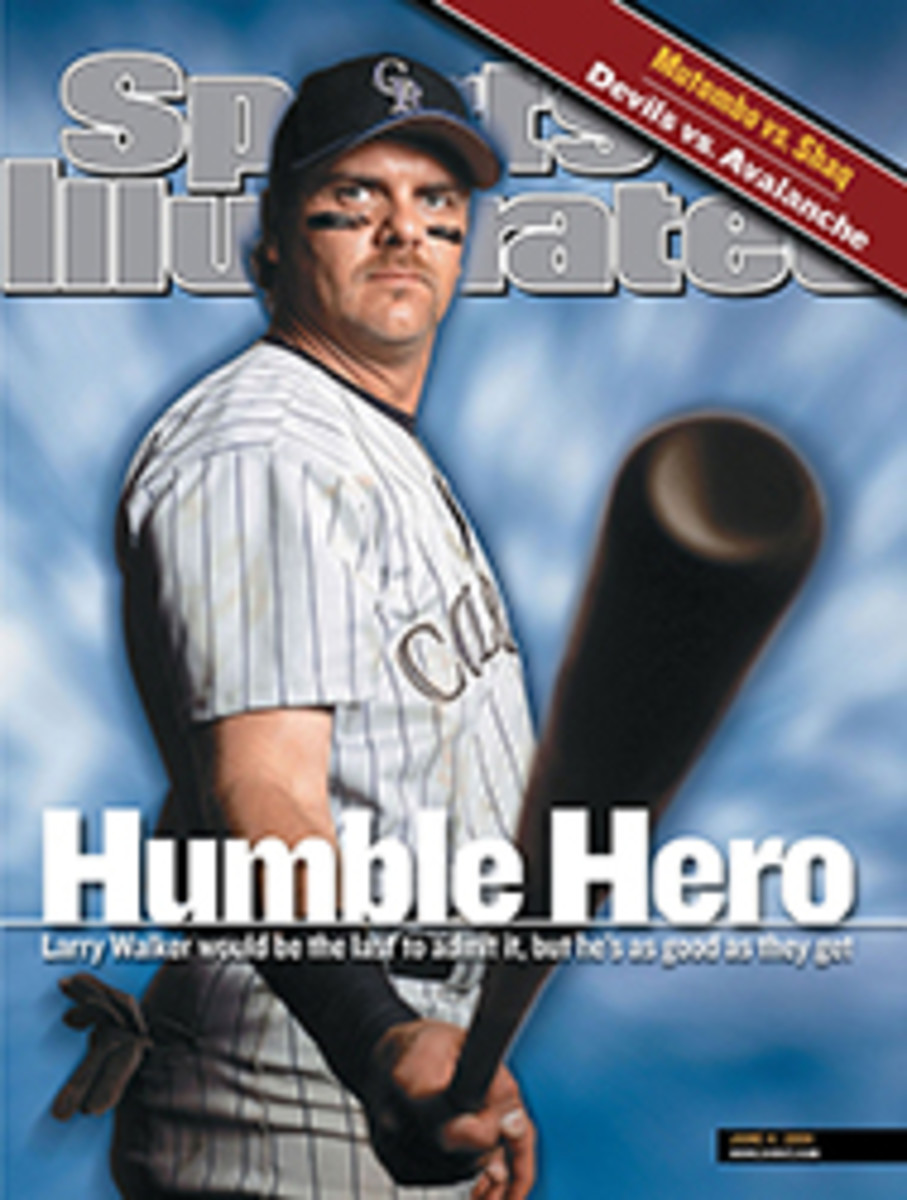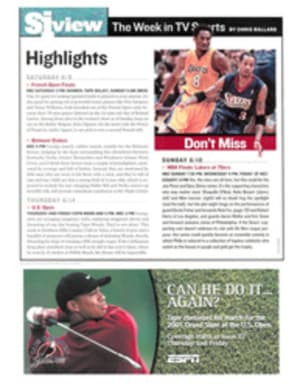
Bop Till You Drop There aren't many great fighters in the Naval Academy's annual boxing tournament, but there are always plenty of great fights
Dustin Lonero had waited a year for the chance to regain his title
in the Naval Academy's Brigade Boxing Championships, and he
almost lost it in the first round. A champion as a sophomore and
then a loser in a rugged quarterfinal as a junior, Lonero was
intent on winning a title again, this time at 165 pounds. "This
means everything to me," he said several days before the fight.
Less than a minute into the championship bout he was on the verge
of a knockout: his own. Tommy Clarke, a taller, long-armed junior
majoring in quantitative economics, landed an uppercut followed
by several combinations that drove Lonero into the ropes. As a
crowd of 4,000--including past tournament champions, military
brass and midshipmen wearing dress blues--rocked Halsey Field
House in Annapolis, Md., the ref stepped between the fighters and
gave Lonero a standing eight count. Lonero, stocky and
thick-armed, blood dripping from a gash on his chin that would
require 11 stitches, sagged into the ropes. "I thought, Dustin
isn't even going to make it out of the first round," says Navy
boxing coach Jim McNally, who oversees the tournament.
Boxers seldom capitulate so easily in the Friday night fight club
that has anointed the toughest guys at the academy since 1941.
The brackets in 10 divisions are filled mostly with novices, and
whatever they lack in ring savvy, they make up for with a
willingness to rumble. "The mission of the academy is to instill
the warrior spirit in young people who could be leaders in
combat, and nothing frames that mission better than the brigade
boxing tournament," says Tom Virgets, who trained professional
fighters Iran Barkley, Tommy Morrison and Razor Ruddock and now
directs the academy's physical education department.
Lonero showed that spirit as he came out of the standing eight
count fighting hard. Clarke continued to press him, but Lonero
landed a right hook, and then another, before the round ended.
Both boxers' shirts were spattered with blood as they turned and
walked back to their corners. The admirals and the plebes were
buzzing. "This crowd loves a war," McNally said.
"Other than the Army-Navy football game, no event generates as
much interest and support at the academy as brigade boxing," says
Andy Haffele, who won the 195-pound title this year and will soon
join the SEALs, the Navy's elite covert fighting unit. "You've
got violence, you've got blood, you've got friends competing.
This is still primarily a male institution, and it's a highly
competitive place."
The tournament has a starry history at a school where many
customs have become sacred rituals. Oliver North defeated James
Webb in the welterweight final in 1967. North would become a
decorated Marine in Vietnam and later a key figure in the
Iran-Contra scandal of the 1980s. Webb, too, would earn honors in
Vietnam, and he would become a best-selling author (a novel about
the Vietnam War, Fields of Fire) and secretary of the Navy in the
first Bush Administration. "Jimmy has never gotten over losing
that fight," says North, now a radio and cable-TV talk-show host.
Future admirals and generals have also competed, including
Charles Bolden, a two-star Marine general who became a
space-shuttle astronaut, and Thomas Lynch, a rear admiral and
superintendent of the academy.
Each of the three rounds in a bout lasts two minutes, and the
boxers wear headgear and thumbless, thickly padded gloves. "Noses
and pride are the only things that get hurt," McNally says. The
goal isn't fame or a shot at the pros--the men fight for respect
in the halls, a prime currency at the academy. That and a sliver
of immortality: Six decades of winners are listed on plaques in
the academy's old-fashioned brick boxing gym. "It seems like the
whole Navy knows about the brigade championships," Lonero says.
"When I interviewed last fall to get into nuclear power school
[after graduation], it was all the admiral could talk about: How
was I going to do in brigades?"
Like many other participants in the tournament, Lonero had never
been inside a boxing gym before he arrived at the academy.
Growing up in San Jose, he worked long hours for his father's
lawn service and played high school football. "I was one of those
tough little inside linebackers who ran around hitting
everything," he says. He played lightweight football as a Navy
plebe, then discovered boxing.
That spring he lost in the brigade final to a four-time champion.
Then, as a sophomore, Lonero won at 156 pounds and advanced to
the semifinals in the National Collegiate Boxing Association
tournament, in which Navy's club team competes against Army, Air
Force and three dozen other squads, including many from Division
I schools. (The NCAA dropped boxing after a Wisconsin
middleweight died during the national championships in 1960.)
This year Lonero easily won two bouts to reach the final against
Clarke, who had lived across the corridor from him for a year in
Bancroft Hall, the academy's sprawling residence dorm. "That's
the hardest thing about brigades," says Clarke, who lost in the
175-pound semifinals last year. "I can't think of anything more
stressful than getting in a ring and fighting a friend."
There was nothing friendly about the second round of their bout.
Both fighters dropped their guards and traded heavy blows,
"basically agreeing to take punishment for the chance to give
it," Clarke said. Blood from both men dripped on the canvas as
the fans stood and cheered the unabashed aggression."I thought at
first that it might be a tactical fight," Lonero said later, "but
after the first round it was obviously just going to be a war."
Similar tournaments are held every year at Army, Air Force and
Notre Dame--McNally has tried, without success, to arrange a dual
match between his brigade winners and Notre Dame's Bengal Bouts
champions--but none of the other schools match the zeal for boxing
at Annapolis. In the '20s and '30s a powerful Navy program
produced several Olympians and went 11 years without a dual-match
loss under coach Hamilton (Spike) Webb. The school dropped the
sport in 1941 and instituted the brigade tournament. Today all
midshipmen, including female students, take a required boxing
class in their sophomore year.
McNally, a former Philadelphia amateur who sparred in Joe
Frazier's gym in the '70s and is now a top international amateur
referee, doesn't let just anyone into the brigade draw--only team
members and those who distinguish themselves in their classes or
in intramural boxing sessions are allowed. They all train
together for four months before the tournament, putting in extra
conditioning runs before dawn and then sparring, shadowboxing and
exercising in the gym in intense late-afternoon workouts.
The Navy club team has won four NCBA team titles and 34
individual titles in McNally's 15-year tenure, yet for his boxers
the national stage can't compare with the brigade tournament.
"This is the one you want to win," says Pat McCauley, a junior
heavyweight from Dallas who wants to become a SEAL. "You're
fighting in front of everyone, from your friends to the military
leaders who are going to shape your career. There's a ton of
pressure."
McCauley, a defending brigade champion and the hardest puncher on
the team, lost the first two rounds of this year's heavyweight
final to Jeff Watkins, a junior from the Bronx. But in the third
round McCauley, about to be defeated in front of a dozen family
members who were watching him fight for the first time, saw an
opening: Watkins briefly lowered his hands, McCauley unleashed a
left hook and a straight right that dropped him, and the ref
stopped the fight with less than a minute remaining.
Another defending champion who won was 156-pounder Rick Weil, a
sophomore from Huntington Beach, Calif., who 147-pounder Tiko
Crofoot says is "head and shoulders above the rest of us as a
boxer." Named after an uncle who died in Vietnam, Weil was raised
by his father, a car salesman, in a single-parent home. Rick fell
in love with boxing in high school and commuted 90 minutes each
way by bus to work out in a gym seven days a week. In the final
he patiently stalked his opponent, Augur Adams, a converted rower
whose former teammates were providing loud support. Weil quieted
them by repeatedly cornering Adams and pummeling him. "I'm the
first person in my family to go to college," Weil says. "I want
to create some great stories when I'm young so I can look back
later and say I did something."
However, the bout of the night--"the best fight in all my years
here," McNally says--was between Lonero and Clarke. Both whaled
away with both hands throughout the final round, Clarke twice
knocking Lonero's mouthpiece to the canvas, but Lonero landed a
few more shots and narrowly won the round. The crowd roared as
the final bell sounded, and after the announcement that the
judges had awarded the fight to Lonero, the crowd roared more
loudly still as the boxers embraced. "All the respect in the
world," Clarke whispered in Lonero's ear as they stood in the
middle of the ring.
Lonero was still the worse for wear at practice three days
later--the welts on his face, stitches in his chin and cut on his
lip evidence of what he had endured. "I've fought 50 college
bouts, but never anything as wild as that," he said. "I kept
telling myself, 'You're not going to lose; this is your last
brigade final. Come on, keep going.' Now I can't walk five feet
without someone telling me what an awesome fight it was. But I
don't remember much of it. It was just a noisy blur."
Virgets only smiled and shook his head when asked about the
fight. "There's a moment in every bout at every level when
someone tries to assert his dominance over you, and at that
moment you have to give it back or lose," he said. "Both [Lonero
and Clarke] tried to dominate, and both refused to submit. That's
when you get a great fight. You didn't see many boxing skills in
there, but you couldn't miss the warrior spirit."
COLOR PHOTO: PHOTOGRAPHS BY AL TIELEMANS Bloody good Lonero took a pounding en route to his second title, in the 165-pound division.
COLOR PHOTO: PHOTOGRAPHS BY AL TIELEMANS Plebe-iscite The only event at Annapolis more popular than the boxing tournament is the annual Army-Navy football game.
COLOR PHOTO: PHOTOGRAPHS BY AL TIELEMANS Brothers in arms After beating each other silly for three rounds, Lonero and Clarke (in blue) embraced after the bell.
"You've got violence, you've got blood, and you've got friends
competing," says one fighter.
The goal isn't fame or a shot at the pros--the men fight for
respect in the academy's halls.

